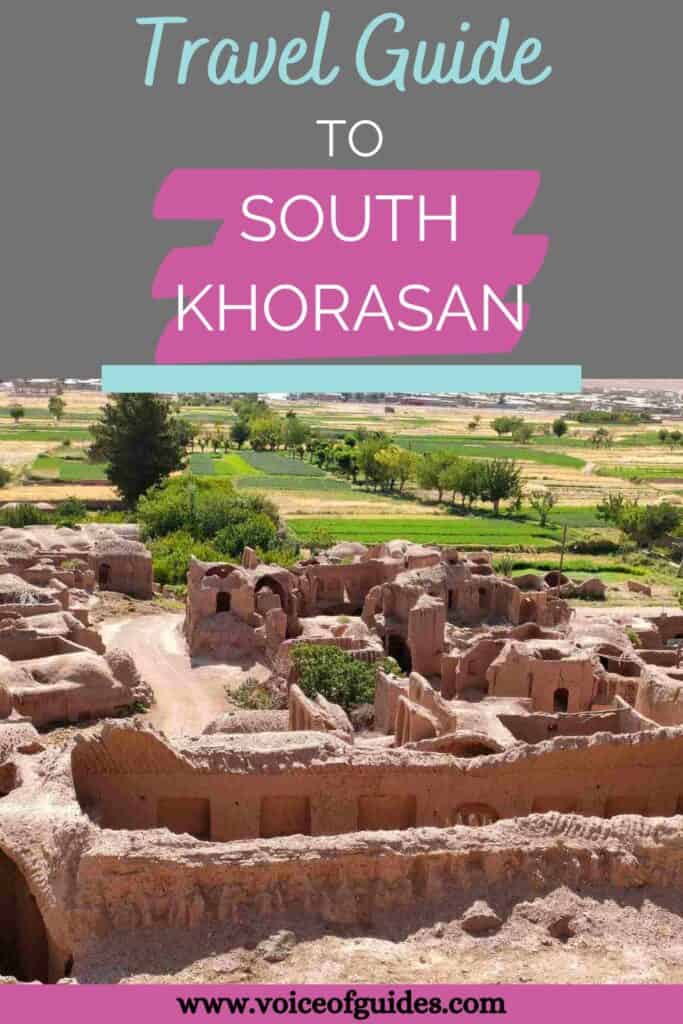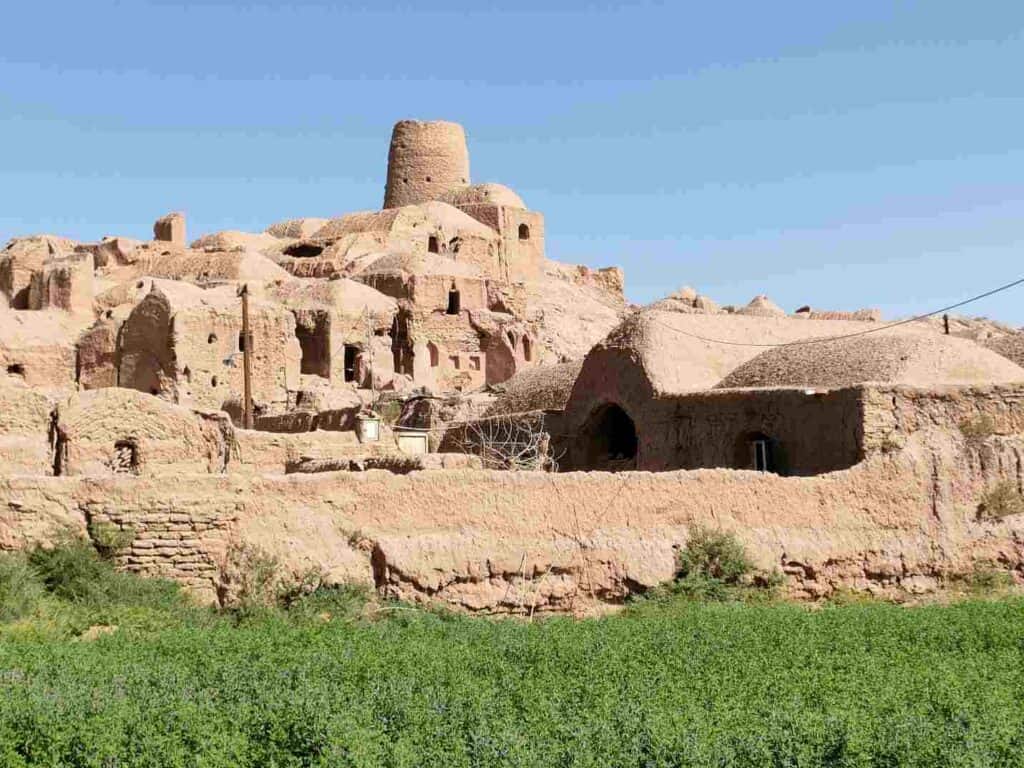This article may contain affiliate / compensated links. For full information, please see our disclaimer here.
South Khorasan is usually not on travelers’ radar as it is far from the more famous tourist attractions, Mashhad to the north and Kerman to the south. I went to this province when I was in Mashhad, returning to Isfahan with a bypass to discover this remote part of Iran. And I had a pleasant surprise. This province has an amazing landscape with mountains, deserts and villages. There may be no famous monuments around here, but it is great to discover the countryside and get to know a less visited part of Iran, where not many tourists venture. Here, you can feel being a discoverer. This travel guide tells you about the best places to visit in South Khorasan, which you can add to your north Iran itinerary.
- What should you know about South Khorasan province?
- What is the best time to visit South Khorasan?
- How to travel around South Khorasan province?
- What are the best places to visit in South Khorasan?
- 1. Qa’en
- 2. Birjand, the capital of South Khorasan province
- 3. Furg citadel
- 4. Makhunik village (Iran’s Lilliput village)
- 5. Khosf
- 6. Deyhuk – a must-see in south Khorasan
- 7. Nayband (170km to the south of Deyhuk)
- 8. Esfahak – one of the nicest oasis villages in Iran
- 9. Tabas
- What to do around Tabas?
- Other articles about Iran
- More articles about the Middle East
- Pin it for later!
- How to plan your trip to Iran
- How to plan your trip to Iran
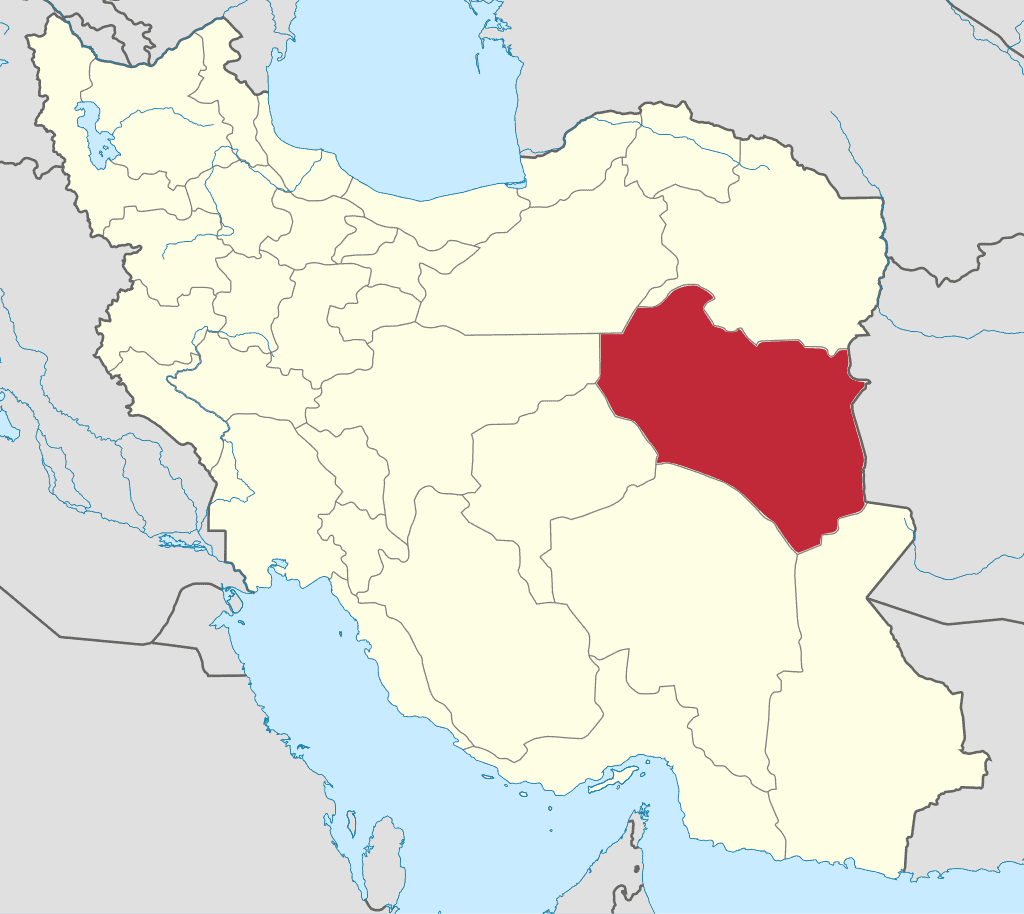
What should you know about South Khorasan province?
South Khorasan is in the central-east part of Iran, having a 140-km-long border with Afghanistan. Because of that, you should be more cautious around the area near the border. Otherwise, the South Khorasan region is equally safe as the rest of Iran. During the Taliban take-over, more Afghan people settled in the province in the summer of 2021.
The biggest part of South Khorasan consists of barren mountains, a deserted area with less vegetation and small towns. The capital, Birjand, has less than 200 000 inhabitants. The highlight of visiting South Khorasan is visiting the oasis villages with mud-brick houses where you can enjoy the countryside in quiet, untouched, non-touristic places and observe the local agriculture.
The best 2 weeks north Iran itinerary
The list of the best books about Iran to get a better understanding
45 things you must know about Iran
Iran is in a deep economic crisis due to international sanctions with a highly devaluated currency. Locals face increasing prices and plenty of restrictions. It also means that Iran has become one of the cheapest travel destinations. While Tehran has the highest prices, the countryside, like the South Khorasan province, is even a lot cheaper for somebody who arrives in the country with euros or dollars. (for the equivalent of 0.8 euro cents, I bought one bottle of water, one bottle of coke, and a bar of small chocolate).
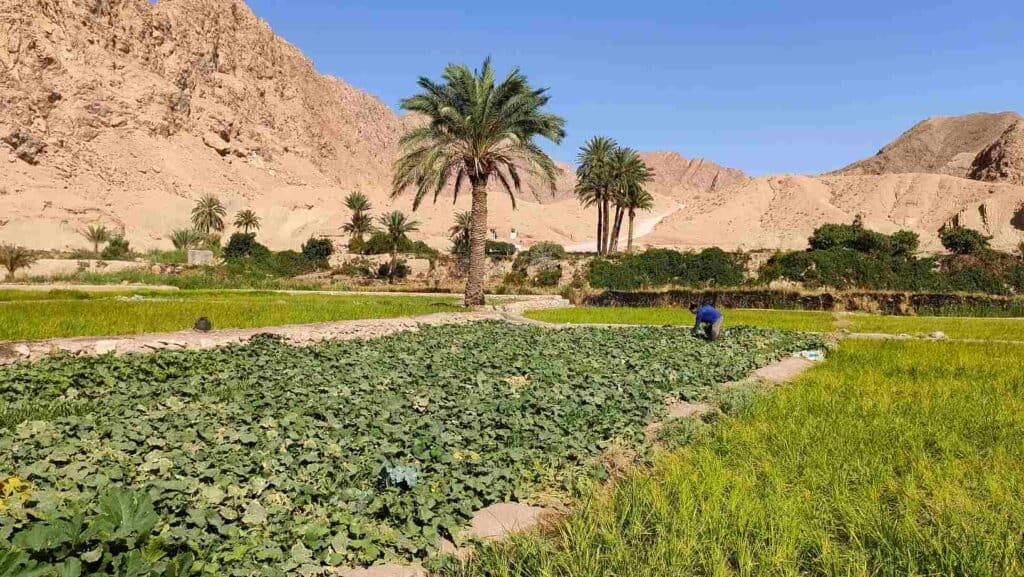
It is hard to meet people in South Khorasan who speak English, unlike in the touristic area around Isfahan and Shiraz. This should not hinder you from discovering the province but be prepared that you need to use google translate more often.
South Khorasan is famous for producing the best quality saffron in Iran.
Because the province is in the far east part of the country, it is dotted with fortresses, citadels and castles, like the one in Birjand.
What is the best time to visit South Khorasan?
The best time to travel around South Khorasan is October- November, and March-May. During summer, the temperature gets very high, while due to the desert climate temperature drops sharply during winter. April is the best time to observe the expansive, purple-colored saffron fields, a staple element of Persian cuisine.
How to travel around South Khorasan province?
Unlike in the central part of Iran, where the most touristic places are located, public transport is much less frequent in this part of the country. Even the big cities are not well connected with long-distance buses that work otherwise perfectly in other regions of Iran. There is no fixed bus schedule, so you should ask on the spot. In the summertime, when the temperature is too hot, they only depart in the morning and the evening. Therefore, it is more difficult to plan your trip to South Khorasan. This is what happened to me in June. Buses did not depart due to the increased temperature until evening.
How to plan your trip to Iran
Book your flight to Iran: I always use Google Flights, Skyscanner or Wayaway to find the cheapest flight tickets worldwide. To get an extra 10% for your Wayaway Membership Plus program use my discount code VOG
Important: Booking.com and other common platforms do not work due to international restrictions in Iran. The only exemption is Skyscanner, where you can book both your international flight and accommodation in Iran!
Book your accommodation in Iran: Hostelworld.com offers a limited number of hostels. All other services are only available through local travel agencies, like 1st Quest.
Get your visa to Iran: 1st Quest or Tap Persia local companies can easily arrange your insurance for Iran
Book domestic flights, hotels, transfers, bus and train tickets, and local tours, all in one place via 1st Quest travel agency.
Another good thing is that by using my discount code, you get an extra 5% off your bookings: VOG%1stQ
Virtual Private Network (VPN): Use VPNExpress, the fastest and best Virtual Private Network to get access to blocked sites in Iran and to prevent hackers from stealing your private information.
Insurance to Iran: 1st Quest or Tap Persia local companies can arrange for you visa to Iran
Book local guides and local tours: Pirsik is specialized in offering tour guides and local tours in less touristic countries, including Iran.
As locals also do, you occasionally need to hitchhike due to the lack of public transport between small towns and villages. It should not be a problem as it is common around there. Drivers often automatically stop asking if you need a lift without looking for that. In maximum ten minutes, you will find somebody to take you.
One thing about hitchhiking. In my post about what you can and cannot do in Iran, I also mention that you should avoid giving a thumbs up as it means the same as showing your middle finger in Western countries. You should just wave your hand facing down…….. It is generally better to avoid truck drivers, especially if you are a solo female traveler, since they may ask if you want something else.
What are the best places to visit in South Khorasan?
1. Qa’en
Qa’en is a relatively big desert town on the Mashhad-Zahedan Road. It is famous for its good quality carpets and saffron and has some historical monuments that are worth a visit.
The Jameh Mosque (Friday mosque) stands in the city center with an exceptional checkered white-and-sepia detail. The mosque is said to date back to the 9th century.
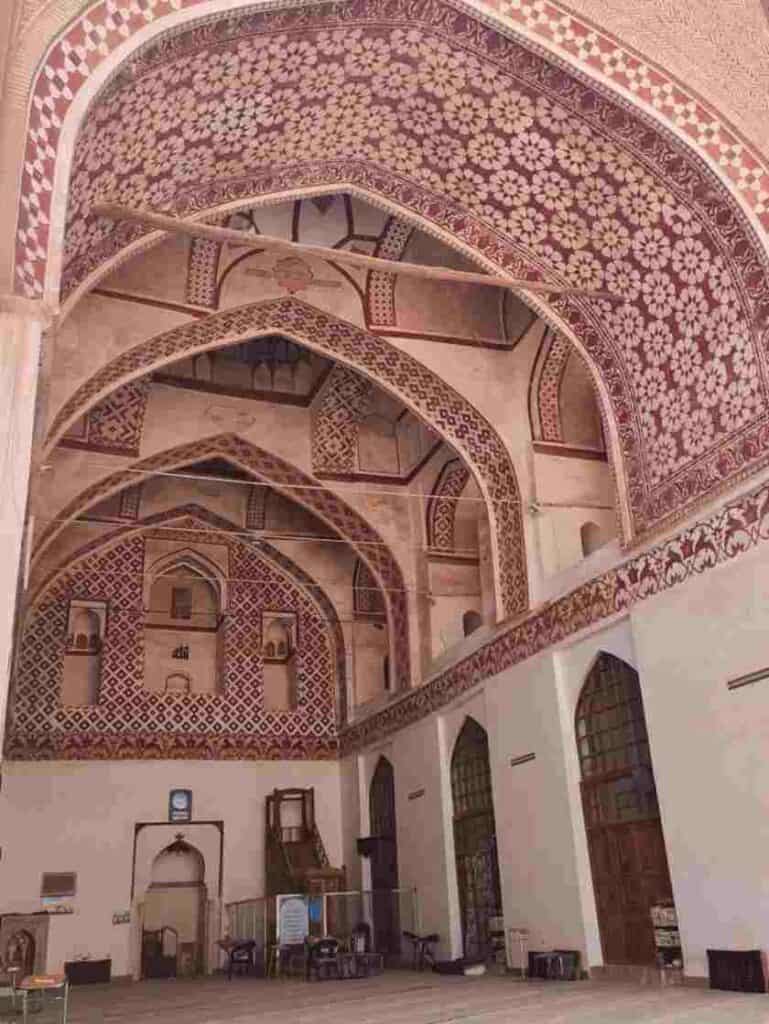
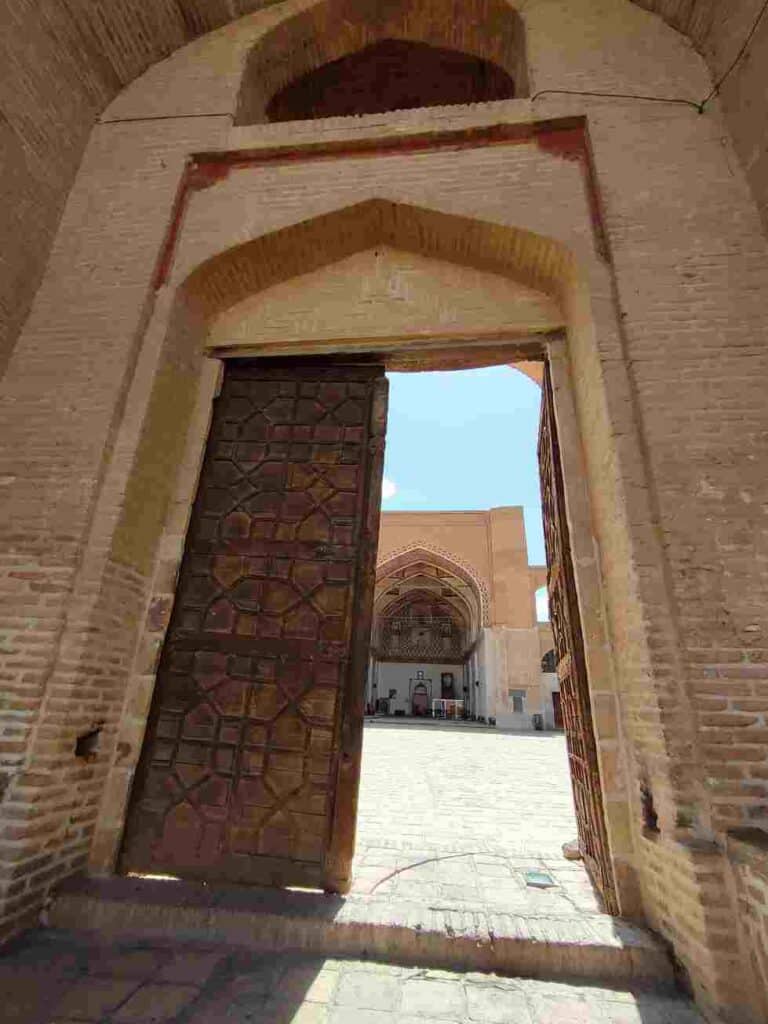
The ruins of Qa’en Castle are seen on the top of the mountains fortified. It is one of the many fortresses around South Khorasan that was used to defend the area from the Uzbek occupiers in the 16th century.
Close to the fortress, the ancient and beautifully restored tomb of 6th-century vizier-philosopher Bozorgmehr is another famous sight of Qa’en.
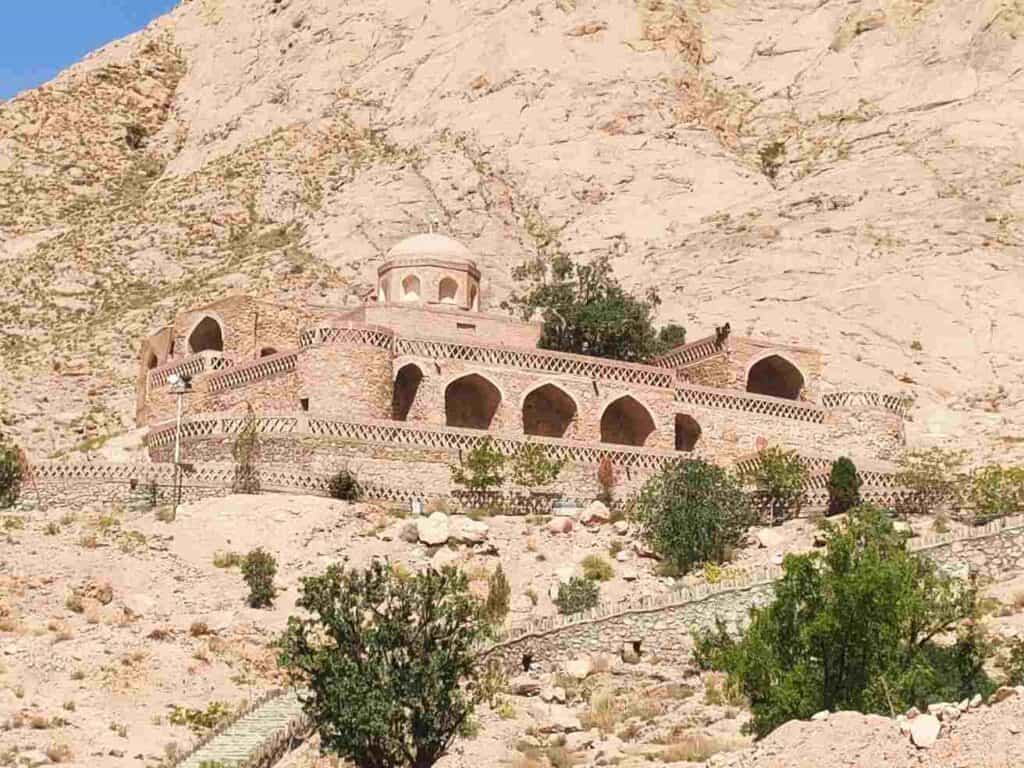
How to get there?
From Mashhad to Birjand: there is only one bus at 8.30 am that takes approximately 6 hours, 1.3 million Rial (~4 USD).
On the way, you can get off at Qa’en and catch a shared taxi to Birjand (300 000 Rial)
From Mashhad to Tabas: the only daily bus departs at 8 am.
2. Birjand, the capital of South Khorasan province
Birjand is the capital of South Khorasan province that is known for saffron, barberries, and especially annab (jujube fruit, considered a herbal remedy for coughs and colds). Like many other cities, it also has a long tradition of hand-made carpets.
There are a few attractions worth visiting in Birjand.
Qakeh Tarikhi
The Qaleh Tarikhi, the castle of Birjand, is the most famous sight, but do not expect anything impressive. The mud-brick structure was built during the Safavid dynasty-Qajar dynasty as a military fortress against Turkmen and Uzbek attacks. People got to the fort through hidden underground tunnels. Although the castle does not have outstanding architecture, as it was only used for military purposes, it offers a great view of the city. During the Qajar period, the castle was rebuilt. There is a small café in the fortress.
Entrance fee: 100 000 Rial
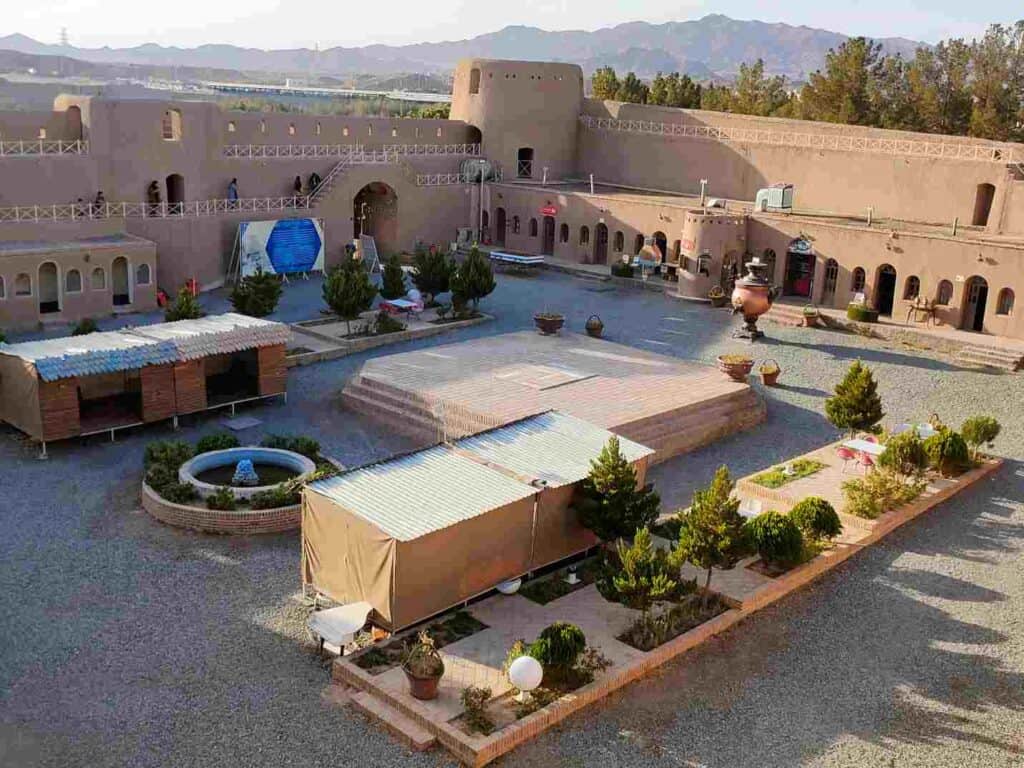
Kolah Farangi Citadel
The Kolah Farangi Citadel has a unique shape with a conical top. It was constructed of brick and limestone at the end of the 19th century. Despite having six floors, only the two bottom floors were used as offices and reception hall. The rooms inside are connected with arched hallways. The citadel stands in the middle of a Persian garden with a pool that had an important role in ventilation.
Akbariyeh historical garden
Besides the castle, the Akbariyeh historical garden, mansion and museum are other highlights of Birjand. It is one of the nine Persian gardens in Iran that enlisted as UNESCO World Heritage, although some doubt why. The two-story mansion in the center, called “Heshmat al-Mulk” mansion, was used by the Qajar governor of the Khorasan region. The mansion now houses an archeology and anthropology museum with ancient pottery discovered in the area. The interior contains wood carving, inlaid work, stained glass decorations, and arabesque and stucco reliefs. The wildlife museum displays the rarest bird species of South Khorasan.
The impressive hall of mirrors was used to welcome local guests and foreign delegates.
Tall pine trees align the main path opposite the mansion, providing shelter.
Entrance fee to the archeological museum: 500 000 Rial
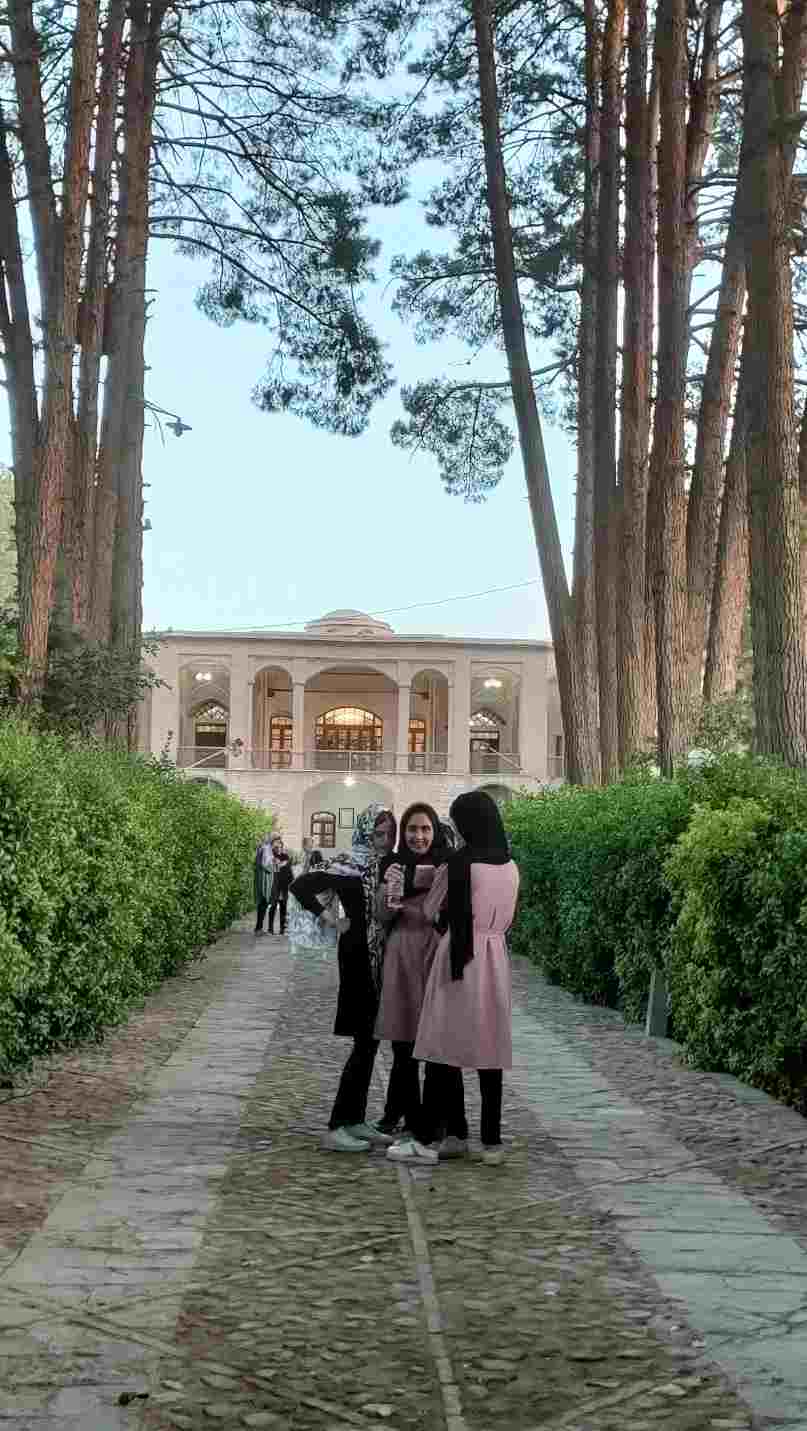
Rahim Abad Birjand garden
Somewhat less-known but still attractive is the Rahim Abad Birjand garden. The central mansion’s ground floor was used as a warehouse, while the representative rooms on the first floor are connected. The Mirror Hall is the most beautifully decorated part of the mansion.
One part is occupied as offices by the Cultural Heritage, Handicrafts, and Tourism.
Entrance fee: free of cost
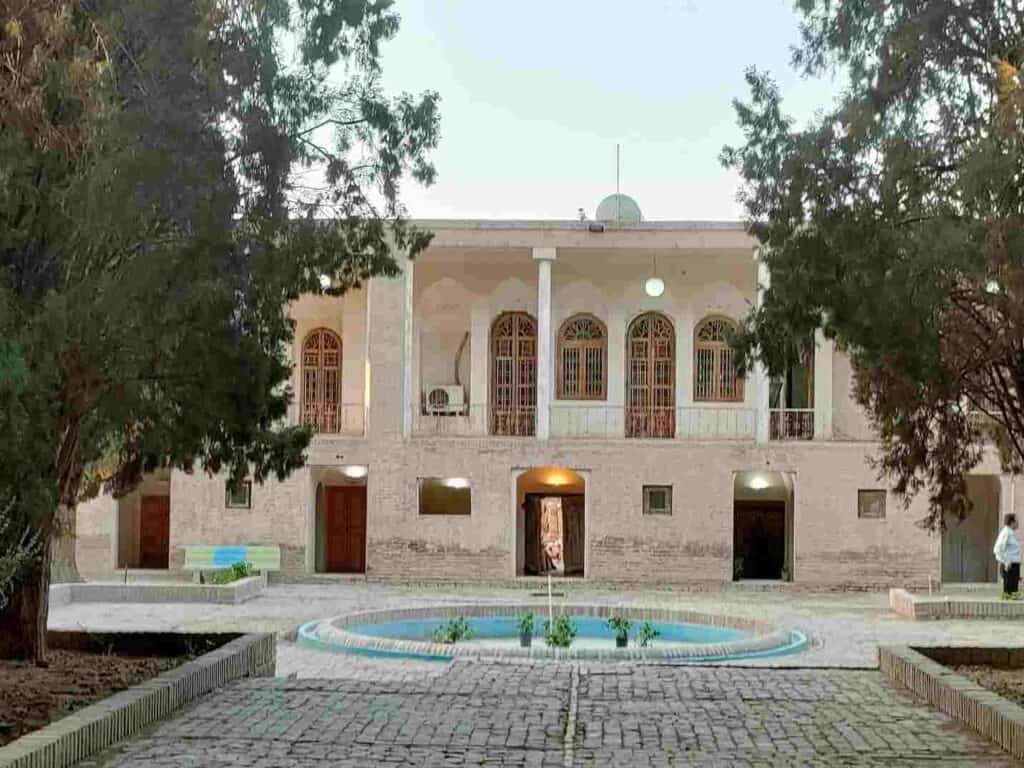
Where to sleep in Birjand?
Birjand Tourist Hotel
Birjand Mountsain Grand Hotel
You can book your hotel in Birjand here
How to go from Birjand to Tehran?
There are regular buses during the day till 7 pm to Tehran. You can get off along the way.
3. Furg citadel
A one-hour drive from Birjand stands another impressive fortress, the 18th century, the Furg Citadel, on top of the hill in Darmian county at 1840 meters. The fort overlooks Furg village and the main roads.
How to get there?
You can take a shared taxi to Sarbisheh and from there take a private taxi to the Furg citadel
4. Makhunik village (Iran’s Lilliput village)
Makhunik is one of the seven weirdest villages in the world and one of the best places to visit in Shouth Khorasan province. It lies only a half-an-hour drive from Afghanistan. Its inhabitants are Afghans, who migrated to Iran several centuries ago. It got its name, Lilliput village, after the tiny houses where the exceptionally small (hardly taller than one meter) residents lived. Everything is minuscule in the Lilliput village: the walls, the doors, the shelves, and the windows. You cannot even enter the home without bending your head. The houses are usually not rectangular and were built very close to each other on the hill slope to blend into the surroundings and escape invaders.
Building miniature houses also had a practical reason. They had to carry building materials from kilometers of distance. Tiny houses were faster to construct and easier to keep warm and cold in extreme temperatures.
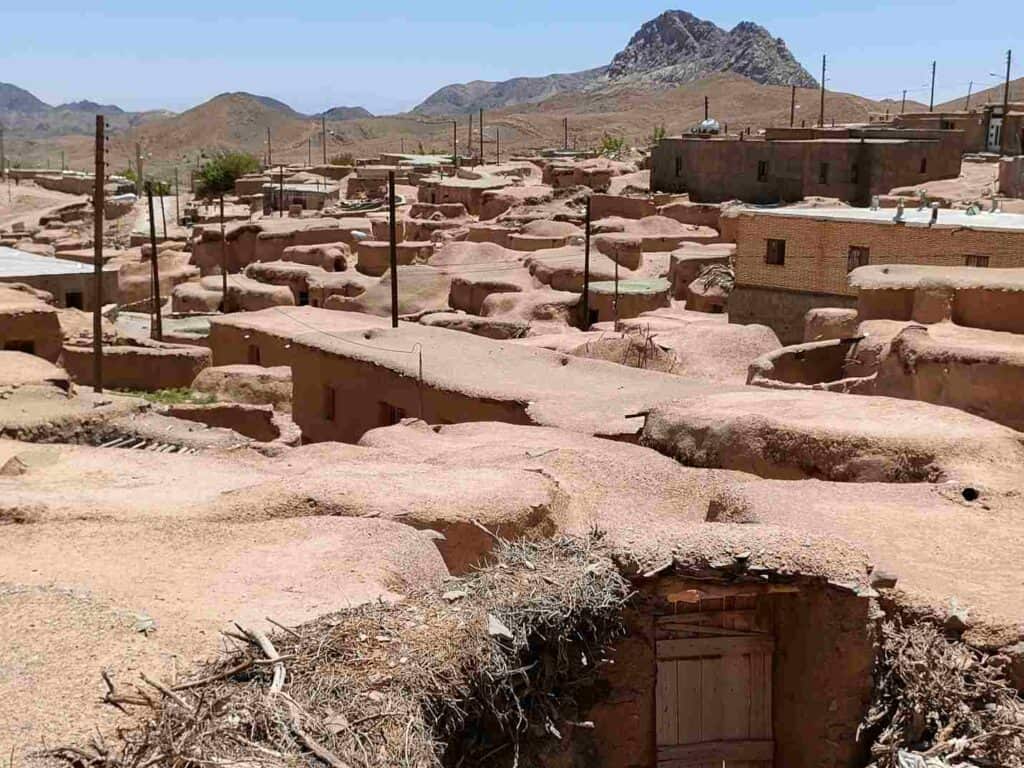
But why were the people in Makhunik village much shorter than everybody else?
They explain that with more factors. Malnutrition and the mercury content of their drinking water probably had an impact on the height of people. The area is dry, harsh, and not favorable for agriculture. Under these circumstances, they could only grow a few vegetables, corn, and fruits. In this isolated village, intermarriage was a necessity. But it caused defective genes, which probably led to dwarfism.
The village is also unique for its long traditions. The residents follow ancient customary law that gives solutions for land disputes, animal husbandry, and family issues.
In the last century, thanks to the general improvement of living standards, the residents have become of average height. When roads were constructed, they could also get nutritious food, like rice and chicken. But as a reminder of the past, out of 200 homes, many were as low as 1.5-2 meters.
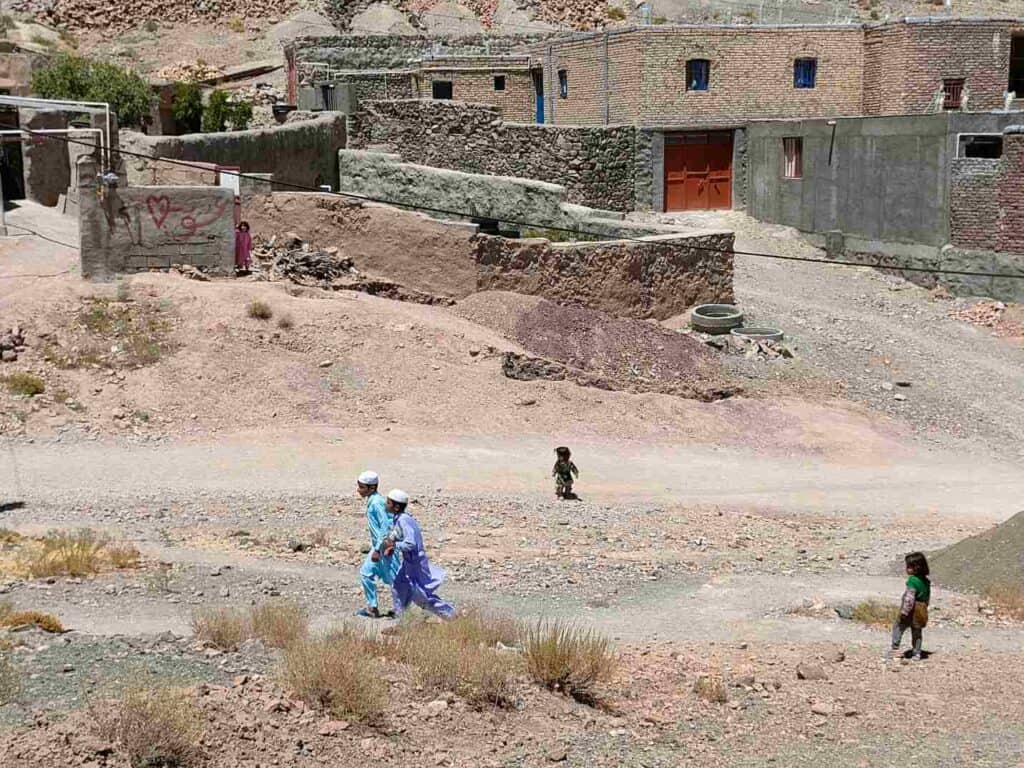
How to go to Makhunik village?
Unfortunately, Makhunik is far from all the tourist places and is difficult to access.
From Birjand to Sharbisheh you can take a shared taxi 300 000 Rial. The price of a private taxi from Sarbisheh to Makhunik is up to negotiation. I paid 1.5 million rials for the driver, including a 1-hour waiting time.
From Tehran to Makhunik village:
There is a direct bus from Tehran South Terminal to Birjand, but that route is very long and boring (~ min 1,760,000 IRR). You can also go from Yazd to Birjand (~900,000 IRR).
From Mashhad to Makhunik village:
Take a bus from Mashhad to Birjand first that approximately 6 hours, 1.3 million Rial (~4 USD).
5. Khosf
Within only 40 minutes’ drive from Birjand, you can reach this gem called the “mini-Yazd”. Even the guidebooks do not mention the village with a range of mudbrick houses similar to Yazd.
Khosf town is famous for being the birthplace of Sima Bina, “the grand lady of Iranian folk music”. She collected and revived the almost forgotten folk music all over Iran, from the Baloch to the Turkmen music, and did extensive research on that. Since the 1990s, she has been invited to an international concert to perform Persian classical music. She currently lives in Cologne in, Germany, and in Tehran.
Stroll around the alleys aligned with mudbrick houses, observe local agriculture, and visit the tomb of Ibn Hosam Khosfi, a prominent poet of the fifteenth century.
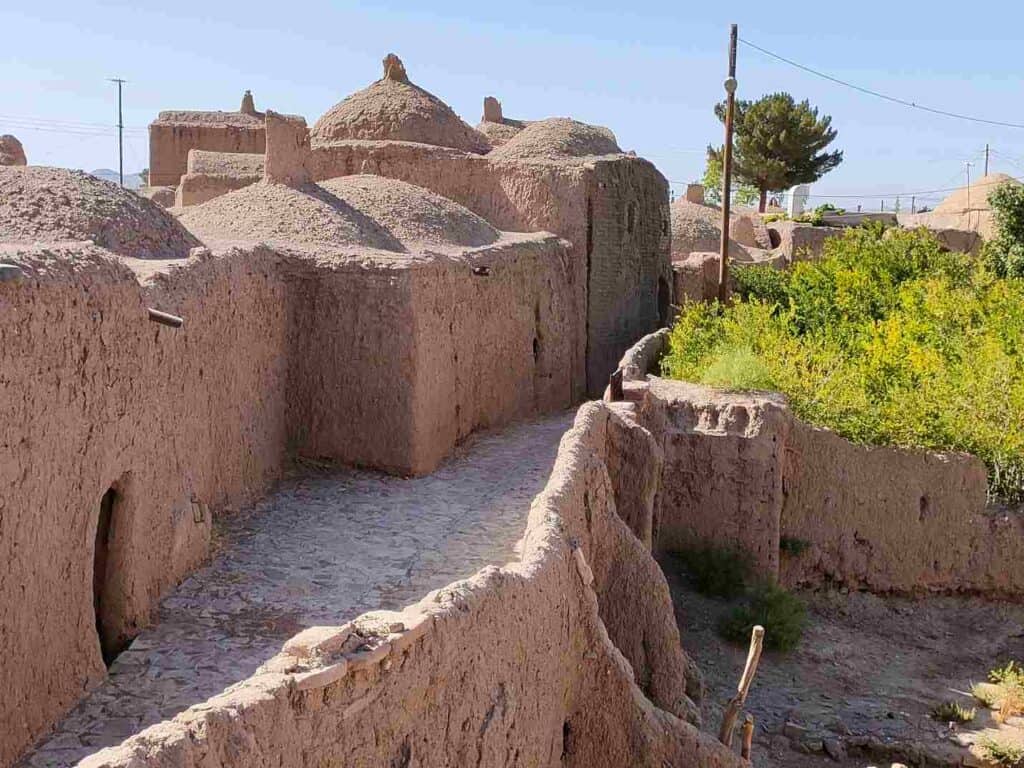
Where to sleep in Khosf?
Ibn Hesaf Gesut guesthouse is more or less the only place to stay in Khosf. It is a lovely traditional guesthouse made of mudbrick with an inner courtyard, some simple and clean rooms. (1.3 million Rial per night).
How to get to Khosf?
Do not take a taxi from the center, but head to the taxi stand on the outskirt of Birjand. From here it costs 600 000 Rial.
6. Deyhuk – a must-see in south Khorasan
Deyhuk is another picturesque village between Khosf and Esfahak with a group of mud houses. You can climb to the top and have a great view of the village.
Esfandiar village is 50 km to the south of Deyhuk. Locals told me that if I go to Esfahak and Deyhuk, I should not go there as it is not sospecial. So, I didn’t.But I mentioned it so that you know about it.
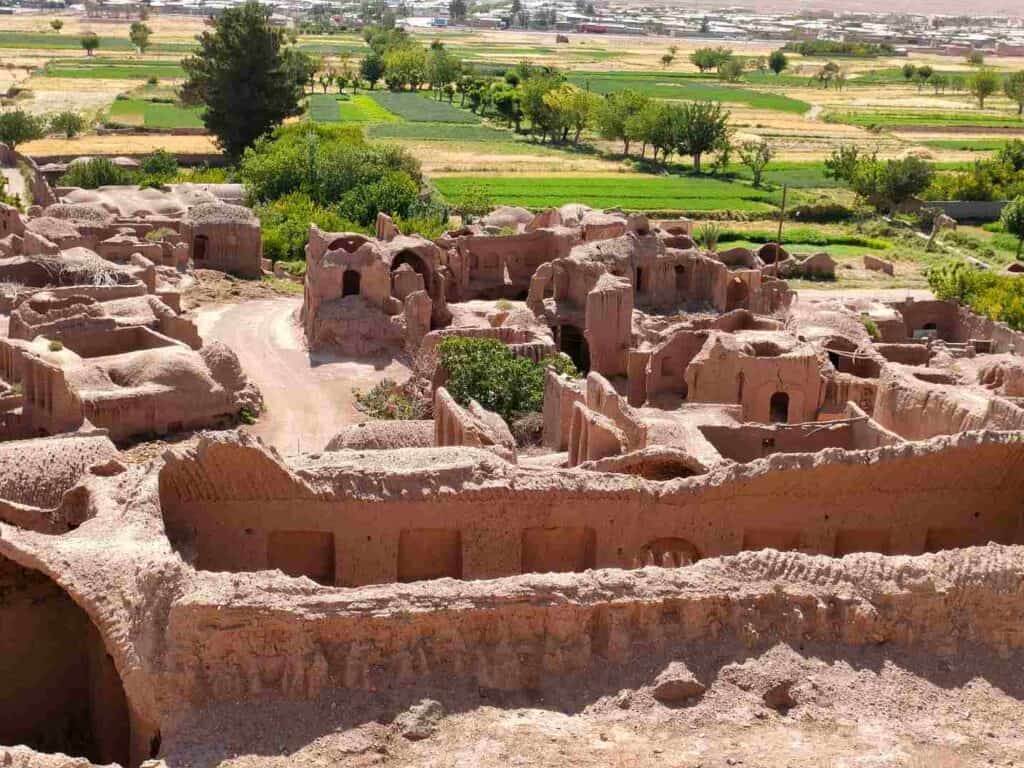
Where to sleep in Deyhuk?
Entezam motel and garden 1 million rial
Chapileh guesthouse is the most famous village directly in the old part of the city, but it was closed when I was there in May 2022.
How to go to Deyhuk?
The taxi from Birjand to Deyhuk costs 1 million rials (2 and a half hours). You take the taxi to Tabas and get off at Deyhuk.
7. Nayband (170km to the south of Deyhuk)
Nayband is probably the most beautiful stepped oasis village surrounded by citrus and palm trees a bit further south along the road to Kerman.
The village dwellers can grow various crops and vegetables thanks to the qanat system (underground water channel).
How to get there?
From Deyhuk to Nayband: It is a one-and-a-half-hour drive from Deyhuk (130km).
From Birjand to Deyhuk: Take the bus from Deyhuk to Kerman and get off at Nayband.
8. Esfahak – one of the nicest oasis villages in Iran
You do not need to make an extra tour to get to Esfahak as it is located along the Deyhuk – Tabas main road. There is a restaurant at the entrance of the village and a spring to get some fresh water. Stroll around the alleys separating the mudbrick houses. One part has been renewed where there are some traditional guesthouses. They are open during the season (in autumn and spring). Esfahak was also heavily destroyed during the earthquake of 1978, and they built a new village next to that. The partly collapsed abandoned adobe houses still exist.
Date palms surround the charming village, and a traditional bathhouse has been restored.
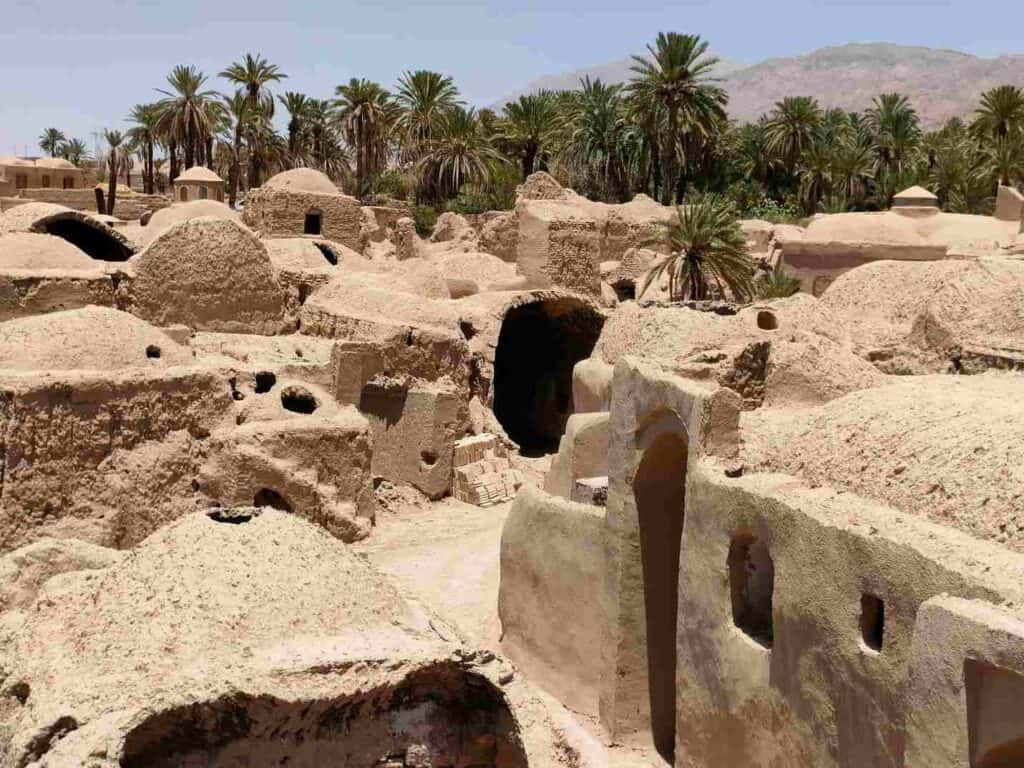
Where to sleep in Esfahak?
Since there are some traditional guesthouses in Esfahak, it is a great place to stay for the night and enjoy the village atmosphere.
The mollah Mokhtar eco-tourism center
The Saracheh ecotourism center
Kavir traditional guesthouse
How to get there?
Private taxi from Deyhuk to Esfahak: 500 000 rial
9. Tabas
Tabas became well-known during the hostage crisis in 1979 when the US mission failed to free the hostages when the rescue helicopters crashed.
On 4th November 1979, 52 employees of the American embassy in Tehran were taken as hostages by Iranian students during the Islamic Revolution that dethroned the Shah and turned the country into the Islamic Republic under the leadership of Khomeini Ayatollah. The hostages were held for 444 days. During this time, the US made attempts to free the hostages, but all of them failed. On 24th April 1980, eight helicopters flew to the road in the Great Salt Desert of Eastern Iran in Operation Eagle near Tabas. The heavy dust storms disabled two helicopters. When a third helicopter was found unserviceable, President Carter approved aborting the mission. As the helicopters repositioned themselves for refueling, one ran into a C‑130 tanker aircraft and crashed, killing eight US servicemen and injuring several more. The mission was publicly declared a failure, and Khomeini ayatollah considered it a divine intervention in protecting Islam. However, there is a lot of mystery and guesswork around what happened.
Read the book Argo about the incredible story of CIA agent Tony Mendez who rescued American diplomats from Iran during the hostage crisis with a creative cover story.
An earthquake with a magnitude of 7.4 shook Tabas in September 1978 killing 15, 000- 20 000 people. Other villages like Esfahak were also affected, but Tabas was the most severely hit. The mudbrick buildings quickly collapsed.
Tabas citadel (Arg-e Tabas)
It dates back to the pre-Islamic period, although it has been rebuilt several times since then. It was a small enclosed area where people found refuge in war times. Before the earthquake of 1978, 60% of the citadel was intact. Its only inhabitant was Agha Seyed Ali Mirza, buried under the rubble after the earthquake. Twenty-four years after the disaster, his body was found intact during the reconstruction and was buried inside the citadel.
In June 2022, during my visit, the citadel was closed due to renovation.
How to plan your trip to Iran
Book your flight to Iran: I always use Google Flights, Skyscanner or Wayaway to find the cheapest flight tickets worldwide. To get an extra 10% for your Wayaway Membership Plus program use my discount code VOG
Important: Booking.com and other common platforms do not work due to international restrictions in Iran. The only exemption is Skyscanner, where you can book both your international flight and accommodation in Iran!
Book your accommodation in Iran: Hostelworld.com offers a limited number of hostels. All other services are only available through local travel agencies, like 1st Quest.
Get your visa to Iran: 1st Quest or Tap Persia local companies can easily arrange your insurance for Iran
Book domestic flights, hotels, transfers, bus and train tickets, and local tours, all in one place via 1st Quest travel agency.
Another good thing is that by using my discount code, you get an extra 5% off your bookings: VOG%1stQ
Virtual Private Network (VPN): Use VPNExpress, the fastest and best Virtual Private Network to get access to blocked sites in Iran and to prevent hackers from stealing your private information.
Insurance to Iran: 1st Quest or Tap Persia local companies can arrange for you visa to Iran
Book local guides and local tours: Pirsik is specialized in offering tour guides and local tours in less touristic countries, including Iran.
Imamzadeh Hussein ibn-Mousa
In the center of Tabas stands the surprisingly impressive religious site, the Imamzadeh Hussein ibn-Mousa. This is the holy shrine of the highly respected Imam Reza’s brother. (Imam Reza is the 8th Shia imam, whose shrine is located in Mashhad, making it the most important pilgrimage site in Iran). It has a large courtyard with palm trees and pools. The interior is rich in mirror decoration that is so common all over Persia.
The Imamzadeh was destroyed during the earthquake in 1978, but it was completely rebuilt.
Important: Women must wear an abaya to enter the shrine, which is available at the entrance.
Tip: cheap accommodation is available for everyone, including foreigners and non-Muslims.
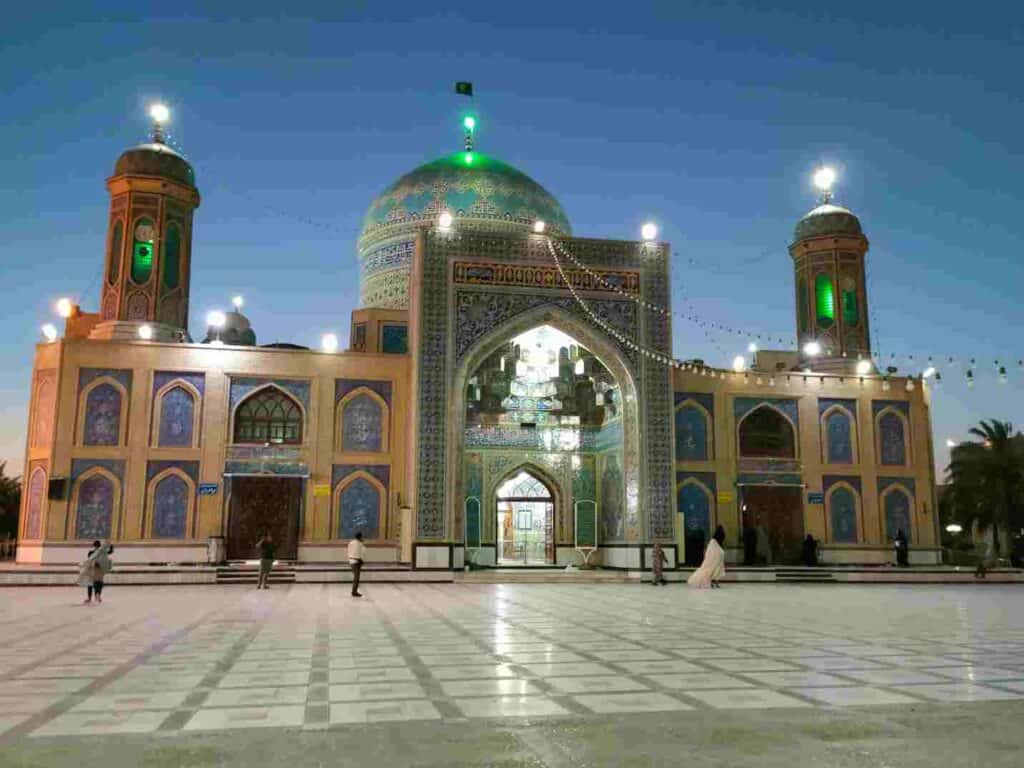
Golshan Garden
This is a huge park in the middle of Tabas, the best place to walk around in greenery in the otherwise deserted region. Ducks and pelicans enjoy the pool in the middle of the park. These pelicans have become a tourist attraction in Tabas.
When is the best time to go to Tabas?
If you plan to go hiking around Tabas, spring and autumn are the best times to do that, although during spring, expect to get more wet due to the higher water level. At some parts in June, the water level reached well above my knees, and sometimes, I passed along the rock to avoid the water. It was not dangerous but instead made the hiking more exciting. During summer, the temperature is too high.
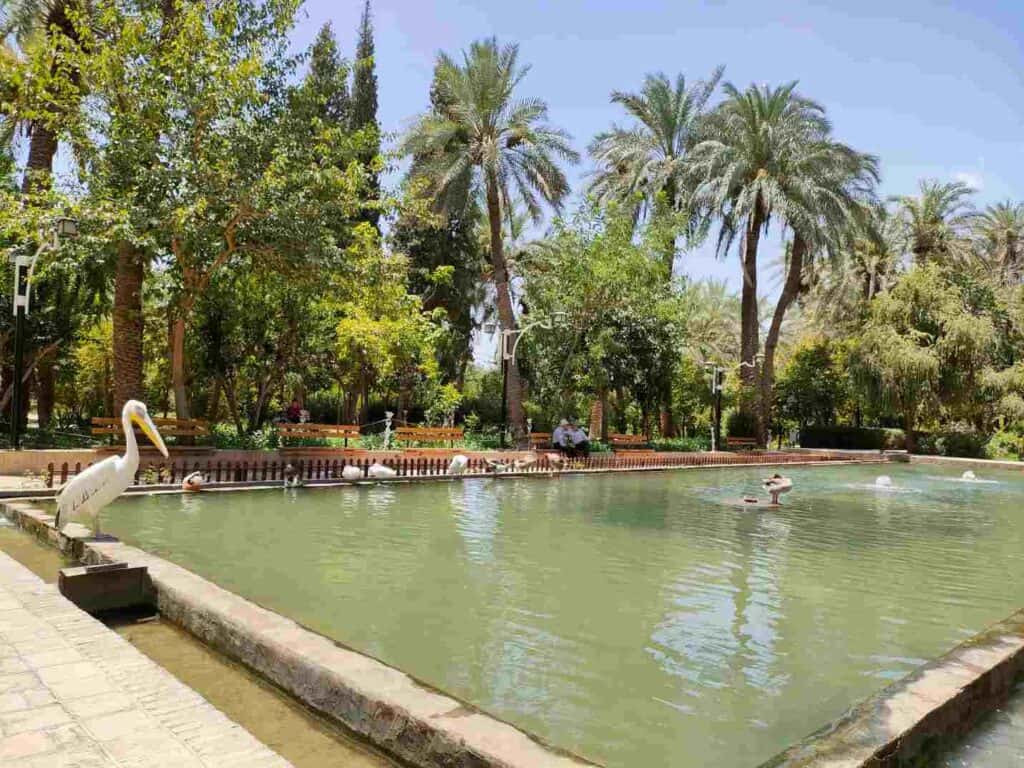
Where to sleep?
There is no traditional guesthouse in Tabas. There are some hotels around the Imamzadeh. Also, pilgrims, including non-muslims travelers, can get a room with a simple mattress and blanket with a shared bathroom inside the Imamzadeh. It costs 1 million rials.
How to go to Tabas?
Tabas is one of the big cities of South Khorasan.
Flight: Tabas has a small airport. Mahan air has two flights to and from Tehran a week in the morning. The flight costs around 8 million Rial. Check it here.
Please note that after my departure in Iran, they planned to introduce charging more for foreigners for the flights, which means that this flight price may not be up-to-date for your next visit.
Bus: there are buses to Tehran and Birjand, but not as often as in the more touristic part of Iran. As mentioned above, due to weather conditions, they can be infrequent. Always check on the spot the day before when buses exactly leave.
What to do around Tabas?
Tabas is an ideal place to discover the surrounding with plenty of things to do in nature.
1. Kal-e-Jenni (27 km to the north of Tabas)
The 9 km long valley starts from Ezmeygan and ends in Tabas while crossing the Shotori Mountain Range. The valley is the result of the long-term erosion process and is one of the most beautiful places to visit in South Khorasan region.
The Gabr ancient houses are the most famous historic sites in the geopark that date back to the Sassanid times (3-7th century). This is what the Zoroastrians were called after Islam. For that, they believe that Zoroastrians lived here earlier. The central corridor is 18-meters-long with cubic-shaped rooms on either side. You must take a flight of stairs to go down to the Gabr houses carved into the wall.
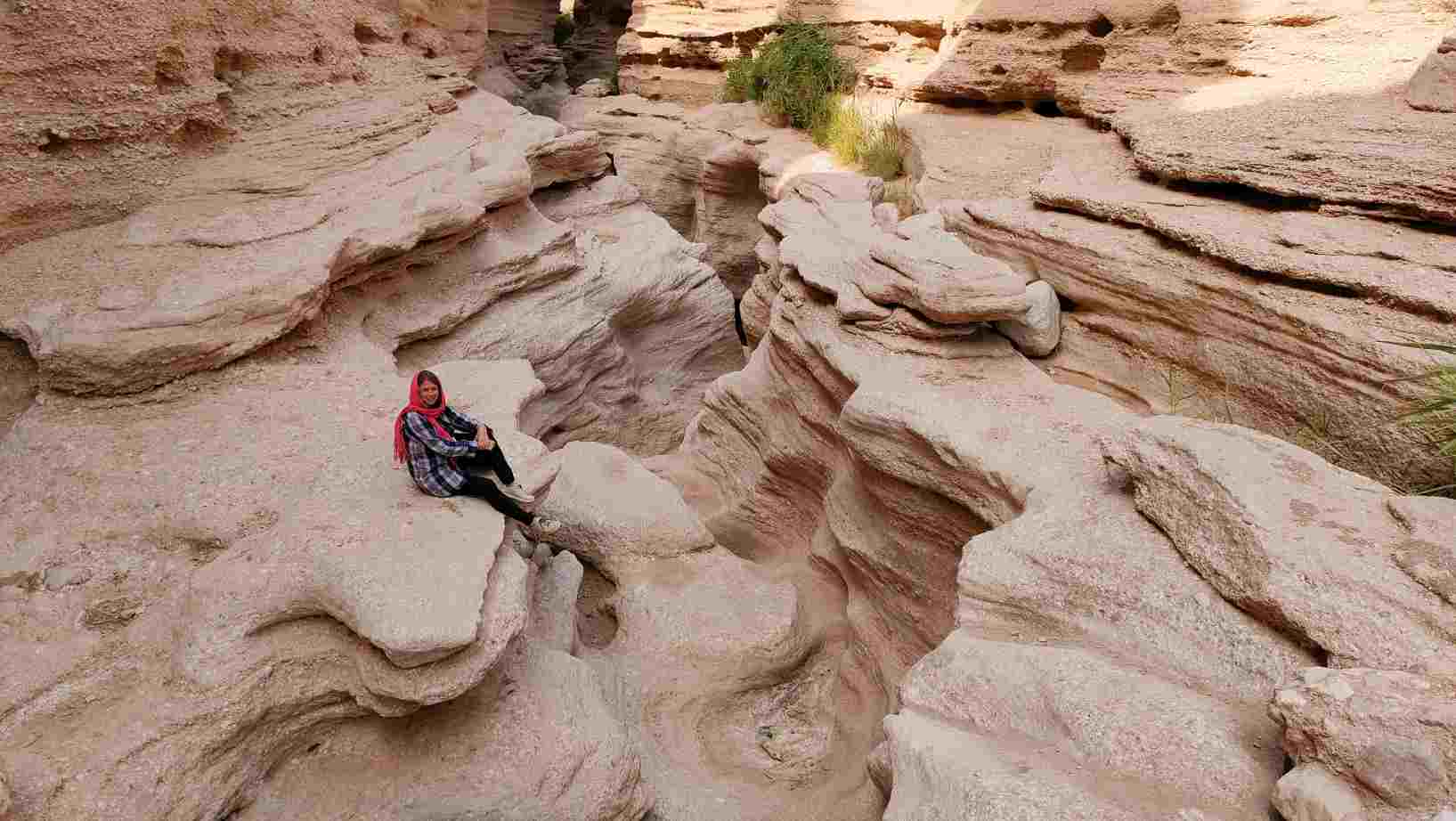
2. Morteza Ali Fountain and Shah Abbas dam – one of the best things to do around Tabas
With only half an hour’s drive, you reach the entrance of the valley that leads to one of the most extraordinary nature attractions of South Khorasan. As you walk inside the valley, you find several hot and cold springs, the largest of which is the Morteza Ali spring. It is a unique phenomenon that hot and cold springs flow alongside each other in the riverbed without mixing, which you can clearly feel as you walk.
Another interesting point along the path is the Shah Abbas dam, the oldest and, for hundreds of years, the tallest dam in the world. The more than 700-year-old dam connects two mountains. It is made of clay, while the upper part is made of stone.
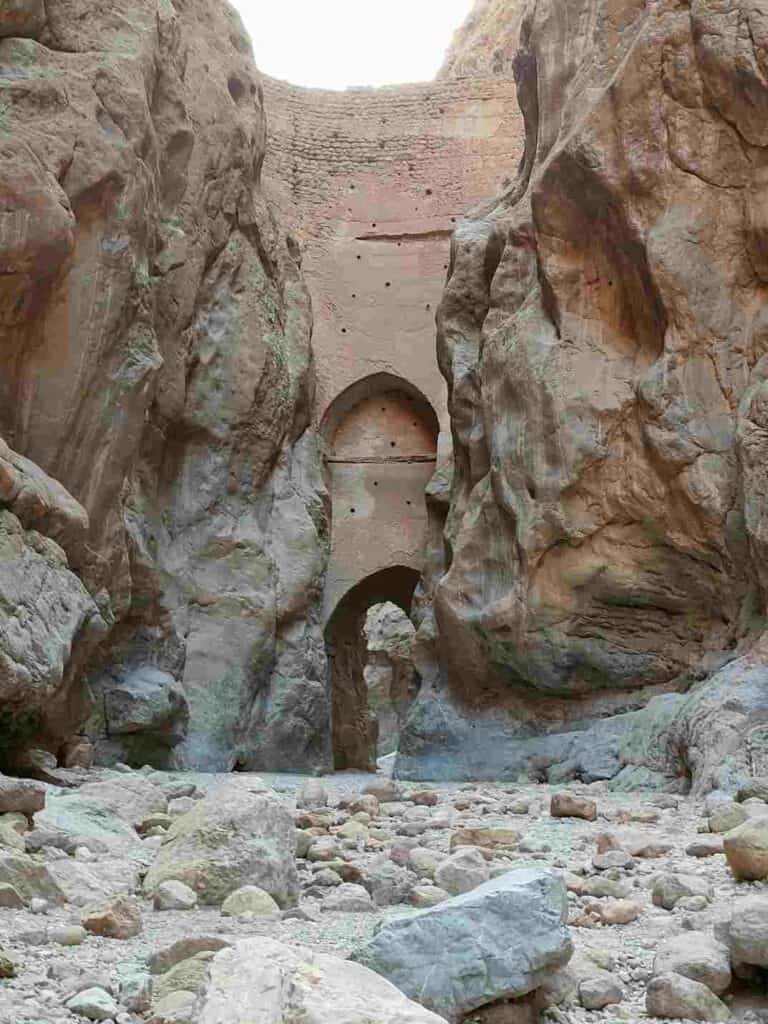
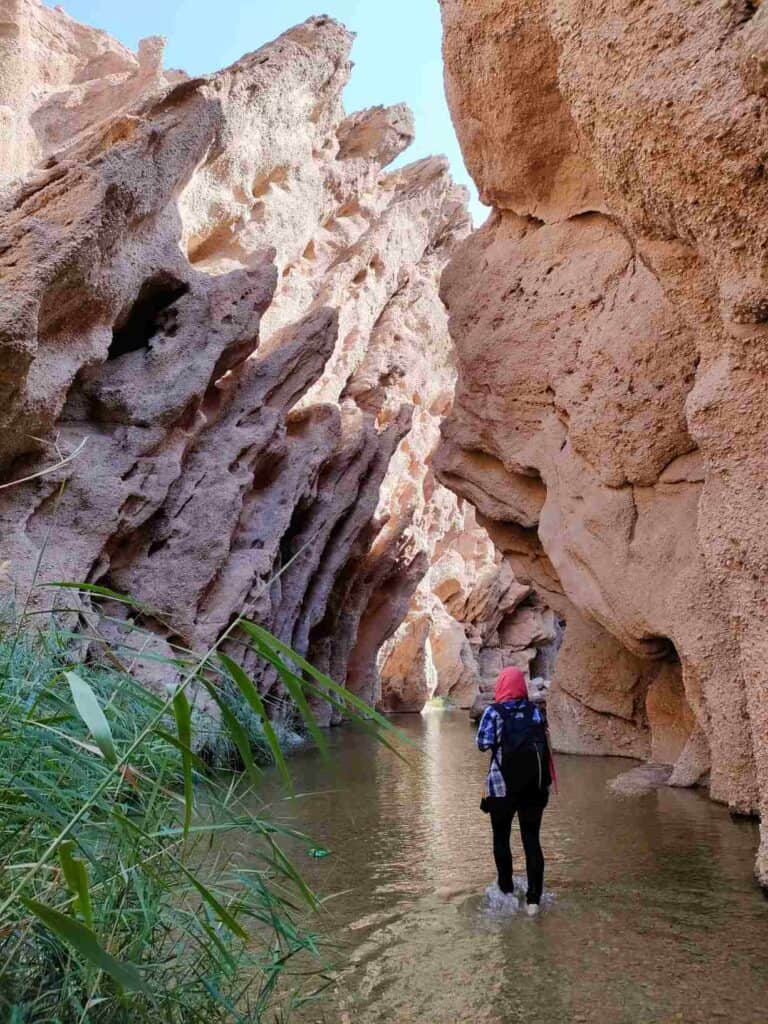
How to go there?
First, you must get to Kharv village, 30 km from Tabas. The path towards the canyon and the springs start nearby. It takes approximately 5 km to reach the fountain traversing the water.
The most famous villages in Iran
3. Ezmeyghan – one of the most beautiful places in south Khorasan
Ezmeyghan is another mudbrick settlement inside a valley close to the Kal-e-Jenni. It is different from other oasis villages of South Khorasan due to the vivid green-colored rice fields at the bottom of the valley. Once you are in the center of Ezmeyghan, follow the signs down to the rice fields irrigated by the qanat system. You will find further descriptions of the natural and historical sights of the geopark. Cross the rice fields and head into the valley along the stream. With a half an hour hike, including some climbing over the rocks, you reach the end with a wider opening up that is an ideal spot for swimming.
Takhte Arous (bridal seat), the white rock in the valley, is another tourist attraction.
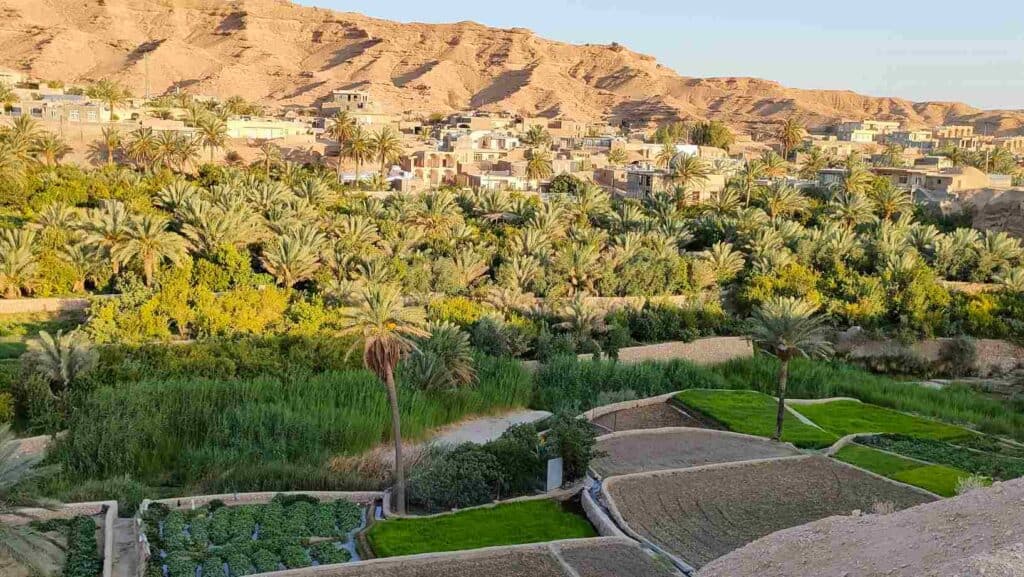
On top of the mountain, above Ezmeyghan, you can visit the only historical monument, the Tomb of Seyed MuhammaJa’farJa’far Tayar from the early years of Islam. According to historical documents, the Muslims killed Muhammad Jafer Tayar when they conquered Khorasan. It is mainly interesting to get there for the view, but you have a great view of the village as you climb the rock on the other side.
Takhte Arous is another tourist site in Ezmeyghan. Its name means the bridal seat, and the reason for this is that it is a huge white rock located at the bottom of a valley, where a river also runs.
Where to sleep in Eymeyghan?
Apart from the Agha Seyed Zabihollah traditional residence, there are few choices. But you can easily return to Tabas.
4. Halvan desert
Iran has so many different types of desert landscapes. If you have been in the Mehr desert, you should still go to the Kavir or other areas that provide a totally different experience, especially if you love the desert as much as I do.
In some parts of the desert, the dunes reach a height of 80 meters, and the combination of mountains and sand is breathtaking. Other parts of the desert have white dunes.
You can stay for the night in the Halvan desert lodge or just go to the desert on the way.
Visiting South Khorasan is a perfect choice for those who like going to off-the-beaten-track destinations and observing life in the countryside and don’t mind facing a less developed infrastructure. The mudbrick oasis villages and fortresses in the barren mountainous landscape are the main feature of South Khorasan. If you come in April, don’t miss to pass by the expansive saffron fields. If you are traveling between Mashhad and Kerman, you can include South Khorasan in your itinerary and enjoy hiking in the Kal-e-Jenni and along the rice fields.
Other articles about Iran
What you can and cannot do in Iran
What you must know before traveling to Iran
What to wear as a foreign traveler in Iran
The best books to read about Iran
The best 2-week itinerary in Iran (the classical route)
The best 2-week north Iran itinerary
All you need to know about the Iranian currency
The best places to visit in Tehran (museums, palaces, religious sites)
The best things to do in Tehran
Travel guide to Tabriz, North Iran
Travel guide to Mashhad, the holy city of Iran
Best things to do in Lahijan, the city of tea in Iran
Best things to do in Ramsar at the Caspian Sea
How to visit Garmeh village, Na’in and Varzaneh desert
More articles about the Middle East
Pin it for later!
